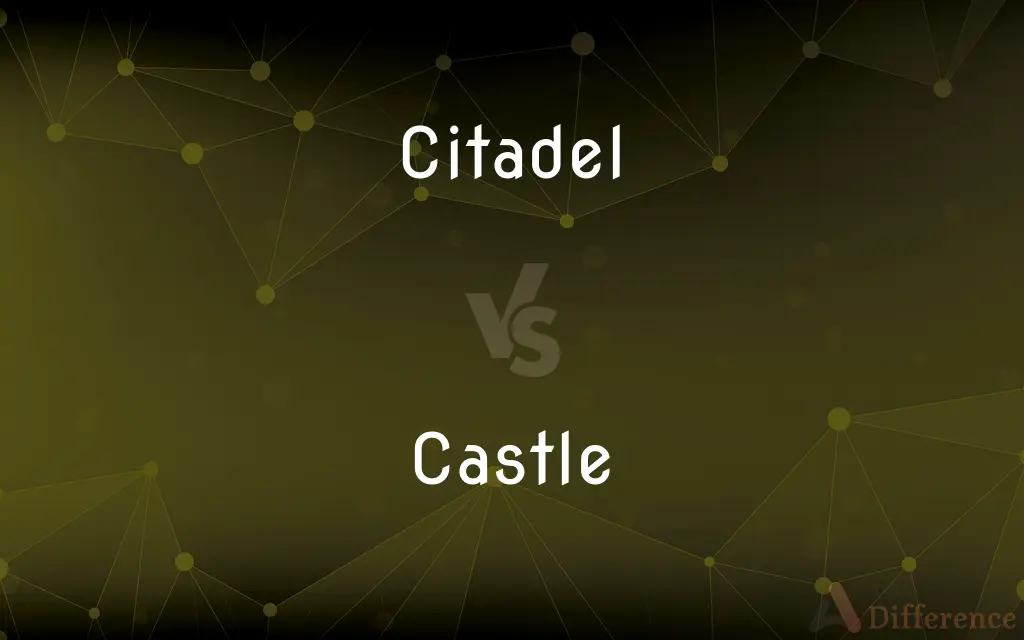Citadel vs. Castle — What's the Difference?
By Tayyaba Rehman & Maham Liaqat — Updated on March 28, 2024
A citadel is a fortress protecting a city, often located at its highest point, while a castle is a large building or group of buildings fortified against attack with thick walls, battlements, towers, and in many cases a moat.

Difference Between Citadel and Castle
Table of Contents
ADVERTISEMENT
Key Differences
Citadels are primarily military structures designed to defend against attacks and serve as a safe haven for the city's inhabitants during sieges. Castles, while also defensive in nature, were typically residences for nobility or royalty, combining the needs of defense with domestic living.
The strategic location of a citadel within a city or on high ground maximizes its defensive advantage, ensuring control over surrounding areas and acting as a final retreat. Castles, on the other hand, were often situated to control key areas such as river crossings, passes, or within territories to assert dominance and control over the land.
While citadels were built for the primary purpose of military defense and often included barracks, armories, and storehouses, castles were designed to be self-sufficient residences that could withstand sieges, equipped with living quarters, chapels, and gardens, in addition to defensive features.
The architectural design of citadels focuses on fortification and strategic military advantages, incorporating features like thick walls, moats, and watchtowers. Castles, while also incorporating these defensive features, display a greater variety in architectural styles, reflecting the period of their construction and the tastes of their inhabitants.
Historically, citadels played a crucial role in the defense of cities across the world, from ancient times through to modern conflicts. Castles, while also significant in military history, are more closely associated with the feudal system and the social and administrative organization of medieval Europe.
ADVERTISEMENT
Comparison Chart
Primary Function
Military defense of a city.
Defensive residence for nobility or royalty.
Location
Often within or adjacent to city walls, on high ground.
Typically in strategic or dominant landscapes.
Design Purpose
Maximizing defensive capabilities.
Balancing defense with residential needs.
Architectural Features
Focus on fortifications: walls, moats, armories.
Defensive and residential: towers, battlements, living quarters.
Historical Role
Protection against sieges and military attacks.
Symbol of feudal power and control, defense against attacks.
Compare with Definitions
Citadel
A stronghold within or near a city designed for defense in warfare.
The ancient citadel stood guard over the city for centuries.
Castle
Served as the administrative hub of a lord's estates.
The castle was not just a residence but also where justice was administered.
Citadel
Situated to oversee and protect the surrounding area.
The citadel's location atop the hill provided a strategic advantage.
Castle
Represents power and authority in medieval society.
The castle stood as a symbol of the lord's dominion over the surrounding lands.
Citadel
Emphasizes strong defensive structures.
The citadel's thick walls and narrow passages were designed to withstand long sieges.
Castle
Reflects architectural styles and historical periods.
The castle, with its Gothic arches and fortified gatehouse, was a masterpiece of medieval architecture.
Citadel
A place of refuge during sieges or attacks.
The city's inhabitants fled to the citadel as the enemy forces approached.
Castle
A fortified residence of nobility or royalty, equipped for defense.
The castle's grand halls and luxurious chambers contrasted its formidable outer defenses.
Citadel
Represents the military and protective presence within a city.
The citadel was a constant reminder of the king's commitment to protect his subjects.
Castle
Designed to protect against invaders, with walls, towers, and sometimes a moat.
The castle's towering walls and deep moat made it an impregnable fortress.
Citadel
A citadel is the core fortified area of a town or city. It may be a castle, fortress, or fortified center.
Castle
A castle is a type of fortified structure built during the Middle Ages predominantly by the nobility or royalty and by military orders. Scholars debate the scope of the word castle, but usually consider it to be the private fortified residence of a lord or noble.
Citadel
A fortress in a commanding position in or near a city.
Castle
A large fortified building or group of buildings with thick walls, usually dominating the surrounding country.
Citadel
A stronghold or fortified place; a bulwark.
Castle
A fortified stronghold converted to residential use.
Citadel
A strong fortress that sits high above a city.
Castle
A large ornate building similar to or resembling a fortified stronghold.
Citadel
A stronghold or fortified place.
Castle
A place of privacy, security, or refuge.
Citadel
An armoured portion of a warship, housing important equipment.
Castle
(Games) See rook2.
Citadel
A Salvation Army meeting place.
Castle
To move the king in chess from its own square two empty squares to one side and then, in the same move, bring the rook from that side to the square immediately past the new position of the king.
Citadel
A fortress in or near a fortified city, commanding the city and fortifications, and intended as a final point of defense.
Castle
To place in or as if in a castle.
Citadel
A stronghold into which people could go for shelter during a battle
Castle
(Games) To move (the king in chess) by castling.
Castle
A large residential building or compound that is fortified and contains many defences; in previous ages often inhabited by a nobleman or king. Also, a house or mansion with some of the architectural features of medieval castles.
Castle
(chess) An instance of castling.
Castle
A rook; a chess piece shaped like a castle tower.
Castle
(shogi) A defense structure in shogi formed by defensive pieces surrounding the king.
Castle
(obsolete) A close helmet.
Castle
(dated) Any strong, imposing, and stately palace or mansion.
Castle
(dated) A small tower, as on a ship, or an elephant's back.
Castle
The wicket.
Castle
(transitive) To house or keep in a castle.
Castle
To protect or separate in a similar way.
Castle
(obsolete) To make into a castle: to build in the form of a castle or add (real or imitation) battlements to an existing building.
Castle
To move the king 2 squares right or left and, in the same turn, the nearest rook to the far side of the king. The move now has special rules: the king cannot be in, go through, or end in check; the squares between the king and rook must be vacant; and neither piece may have been moved before castling.
Castle
To create a similar defensive position in Japanese chess through several moves.
Castle
(cricket) To bowl a batsman with a full-length ball or yorker such that the stumps are knocked over.
Castle
A fortified residence, especially that of a prince or nobleman; a fortress.
The house of every one is to him castle and fortress, as well for his defense againts injury and violence, as for his repose.
Our castle's strengthWill laugh a siege to scorn.
Castle
Any strong, imposing, and stately mansion.
Castle
A small tower, as on a ship, or an elephant's back.
Castle
A piece, made to represent a castle, used in the game of chess; a rook.
Castle
To move the castle to the square next to king, and then the king around the castle to the square next beyond it, for the purpose of covering the king.
Castle
A large and stately mansion
Castle
A large building formerly occupied by a ruler and fortified against attack
Castle
(chess) the piece that can move any number of unoccupied squares in a direction parallel to the sides of the chessboard
Castle
Interchanging the positions of the king and a rook
Castle
Move the king two squares toward a rook and in the same move the rook to the square next past the king
Common Curiosities
How did the purpose of castles evolve over time?
Over time, the purpose of castles evolved from purely defensive structures to symbols of power, luxury residences, and administrative centers.
How do citadels and castles reflect the societies that built them?
They reflect the military, social, and economic priorities of their times, from the need for defense to the display of wealth and power.
What role did geography play in the location of citadels and castles?
Geography was crucial: citadels were often placed on high ground for strategic defense, while castles were located to control key territories or routes.
Are citadels and castles still used today?
While their original military purpose has diminished, many citadels and castles are preserved as historical sites, museums, or cultural venues.
Did the construction of castles affect the surrounding landscape?
Yes, the construction of castles often led to the development of towns and roads, shaping the medieval landscape and economy.
What is the main difference between a citadel and a castle?
The main difference lies in their primary functions: citadels are military fortresses for city defense, while castles are fortified residences.
Can a castle have a citadel?
Yes, a castle can incorporate a citadel as part of its defenses, especially in larger complexes or city defenses.
Why were citadels built within cities?
Citadels were built within or near cities to provide a stronghold in the event of an attack or siege, offering protection to the inhabitants.
How do the architectural features of citadels and castles differ?
Citadels focus more on purely defensive features like thick walls and armories, while castles also include residential amenities and may showcase a variety of architectural styles.
What is the significance of citadels in modern history?
Citadels have played roles in modern conflicts and revolutions, serving as military bases or symbols of resistance.
How were castles maintained and staffed in their prime?
Castles were maintained by a large staff including soldiers, servants, craftsmen, and sometimes even a small community living within its walls.
What materials were commonly used in the construction of citadels and castles?
Stone was the most common material, chosen for its durability and defensive capabilities.
What impact have citadels and castles had on tourism?
They are major tourist attractions, drawing visitors interested in history, architecture, and culture.
Are there any famous citadels that have become symbols of their cities?
Yes, the Citadel of Aleppo and the Tower of London are iconic symbols of their respective cities.
Share Your Discovery

Previous Comparison
Dagger vs. Knife
Next Comparison
Information vs. FormationAuthor Spotlight
Written by
Tayyaba RehmanTayyaba Rehman is a distinguished writer, currently serving as a primary contributor to askdifference.com. As a researcher in semantics and etymology, Tayyaba's passion for the complexity of languages and their distinctions has found a perfect home on the platform. Tayyaba delves into the intricacies of language, distinguishing between commonly confused words and phrases, thereby providing clarity for readers worldwide.
Co-written by
Maham Liaqat















































